#n1 grammar
Text
The Difference Between に and へ
Most of the beginner textbooks will teach learners that に is used for destination and へ is used for direction but there are some explanation that are missing and that is what confusing to many learners.
• 公園に行きます。
• 公園へ行きます。
Both sentences are correct. Both means "I'm going to the park".
But... there is a slight nuance difference. When you use に, you put the destination (which is the park) as the main thing you want the listener to know that the place you want to go is the park. The final destination you will arrive at is the park.
On the other hand, if you use へ, you want the listener to feel that you are making a move, you are making a journey, a process, an effort to go to the park. In other words, へ somehow emphasize on your journey to a place.
Let's say you're flying from UK all the way to Australia, that will take at least 20-22 hours by flight. The journey is extremely long and you want the listener to feel that, so you could say by using the particle へ: 私はオーストラリアへ行きます。
Now, the following part is what most teachers or textbooks didn't tell you. A study shows that more and more Japanese people are using に, and へ has gone out of fashion. According to the survey, one of the reasons may be due to globalization and how easily people are connected around the world through the Internet that people don't feel the journey or the distance is long. Therefore, they don't see the need to use へ anymore.
WARNING!!!
There is a grammar point that you MUST use へ instead of に。The pattern is:
へ + の + Noun
Examples:
• 先生へのプレゼント。Gift for teacher.
• 帰宅への道。The way home.
Another situation which needs to use へ is when the news anchor announces this:
台風が北へ向かっています。
The typhoon is heading north.
If you use に and say 台風が北に向かっています, it means you are very sure that the typhoon will land in the north. No one can predict 100% where it will stop or land so it is incorrect to use に in this sentence.
---------------------------------------------------
Vocabulary used in this lesson:
公園 (こうえん) park, playground
プレゼント present, gift
帰宅 (きたく) home
道 (みち) way
台風 (たいふう) typhoon
北 (きた) north
#study japanese#japanese#jlpt#jlpt n1#jlpt n2#jlpt n3#jlpt n4#jlpt n5#language#learn japanese#nihongo#grammar
84 notes
·
View notes
Text
Where to begin when reading native novels to work on reading comprehension?
So, you've made it to the point where you'd like to branch out and read some novels and children's books in Japanese? Then you've come to the right place! Let's talk about three helpful publishers (Kodansha, Kadokawa, and Shueisha) that can make reading native materials less daunting!
The Kodansha Aoitori Bunko Books (青い鳥文庫) were created and published by Kodansha with elementary schoolers in mind, so almost all kanji has furigana on it. The text is larger and there's normally a bit more spacing in between it (like our children's chapter books in English). Just like other children's chapter books, there are occasional photos included. Aoitori Readers include both original series as well as some translations of international literature (i.e., Little Women, Murder on the Orient Express, Sherlock Holmes, etc.). There are also some adaptations of other series はたらく細胞 (Cells at Work) Those books have blue around the cover.


The Kadokawa Tsubasa Bunko Readers (角川つばさ文庫) operate on the same concept, except the series are normally on a more advanced level. With this in mind, they may use more advanced grammar than the Aoitori series. There are original series, but sometimes books/series for a higher comprehension levels will be adapted into Tsubasa Bunko Readers. This includes popular Japanese novels and series as well as international classics (i.e., Chronicles of Narnia, Pippi Longstocking, Anne of Green Gables, etc.). For adaptations of Japanese novels and series, there will be the "regular" version of the novel and then the Tsubasa Bunko version bc it's the same kanji, same grammar, same words. It'll also supply the furigana for those kanjis and might give little annotations or some photos here and there. For example, the award-winning novel 夜は短し歩けよ乙女 (The Night is Short, Walk on Girl) by 森見 登美彦 (Morimi Tomihiko) has both the "regular" publication and the Tsubasa Bunko version. Tsubasa Bunko Readers have green around the cover. Click on the links to get a preview of each version to compare and contrast.
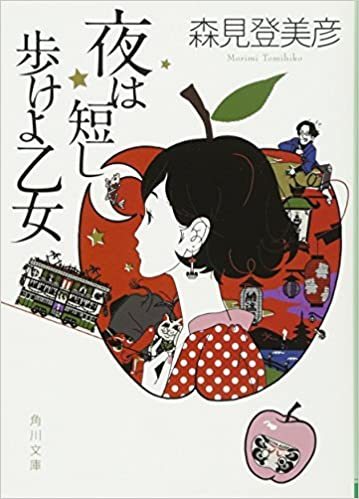

The Shueisha Mirai Bunko Books also operates the same. There are adaptations of manga series (like Kaguya-sama: Love is War and Demon Slayer) as well as original series. Mirai Bunko Readers have orange around the cover.


If you're worried about attempting to read any of these on your own, come suggest some of them for us to read together at the Seitokai Bookclub! (And even if it doesn't get selected immediately, someone might be interested in being a reading buddy with you :D).
Happy reading!
#onigiri thoughts#aoitori readers#tsubasa bunko readers#seitokai bookclub#japanese#japanese reading comprehension#mine#mirai readers#reading resources#looktoki#jpnstudynet#jlpt#japanese reading#jlpt n1#jlpt n3#jlpt n2#jlpt n4#jlpt n5#vocab#jlpt grammar#jlpt reading#jlpt studying#nihongo#learn japanese#kodansha#kadokawa#shueisha
418 notes
·
View notes
Text
文法:〜ては(If・Because + Bad Result/Whenever ~/Repetitive Actions)
A(て-form)+は、B。
In spoken Japanese, ては and では become the contractions ちゃ and じゃ respectively.
We’ve seen ては combine with phrases like ならない、だめ、いけない to mean something that you “must not do.” However, ては has several different uses.
If・Because + Bad Result
Aては、B。
(A[普通形]+のでは、B。)*
If/Because A, then B (Bad Result).
This is the base form for the grammars てはいけない and しなくちゃならない. ては is a conditional whose usage is very similar to ~たら, but while ~たら is neutral, ては carries a negative implication. It's used to express a negative result due to some action, or even just one's negative reaction to that action.* While it's common to see it paired with だめ・ならない・いけない like in the above grammars, it is not limited to those endings.
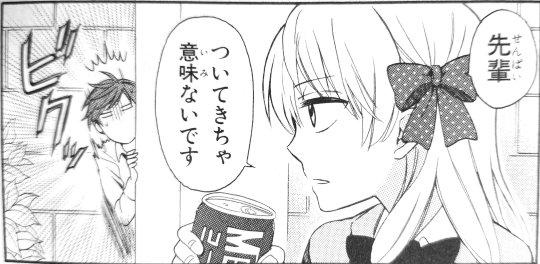
先輩 ついてきちゃ意味ないです[ビクッ]
Senpai, there's no point if you're just going to follow me. [Startled]
[Speaker is on an errand from Senpai to fetch a drink.]
(『月刊少女野崎くん』 Girl’s Monthly Nozaki-kun,vol. 1 by Izumi Tsubaki)
Of course, depending on the translation, these alternate endings can still carry the meaning of "that must (not) be."

未来の僕の奥さんに傷が残っちゃ大変だ
It would be a problem if my future wife were scarred. (= I can't allow my future wife to be scarred.)
(『魔法使いの嫁』 The Ancient Magus' Bride, vol. 1 by Yamazaki Kore)
Whenever ~
While て-form is used to simply connect two clauses to indicate a simple sequence of actions, ては is used to describe an action that keeps happening. In this case, ては is only formed from verbs.*
A(Verb) て、B。
When A, then B.
A(Verb) ては、B。
Whenever A, then B.
These actions are habitual, with B happening every time A occurs. This meaning is not necessarily negative, and the phrase is not repeated.* *
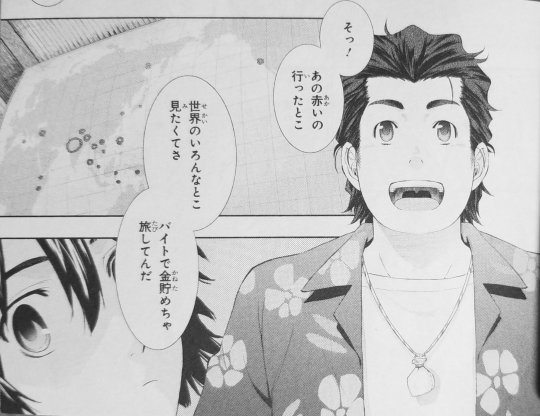
そっ!あの赤いの行ったとこ
世界のいろんなとこ見たくてさ
バイトで金貯めちゃ旅してんだ
Yeah! Those red pins are the places I've been.
See, I really wanna travel all over the world,
And I go on a trip whenever I save up enough money working part-time.
(『あの日見た花の名前を僕達はまだ知らない。』 Anohana: The Flower We Saw That Day, vol. 1 by Okada Mari and Izumi Mitsu)
Repetition
ては can be used to emphasize two actions happening over and over, similar to ~たり~たりする. However, while たり gives several examples (out of many), ては really stresses the repetition.* These two actions can be completely unrelated, even opposite actions. The ては phrase can be repeated twice, or the order of the verbs even inverted to further emphasize the repetition. This form is only formed from verbs.
A(Verb) ては、B。
Do A and B repeatedly, every day, constantly, always.
A(Verb) ては、B、AてはB。
Repeatedly A-ing and B-ing, A-ing and B-ing.
A(Verb) ては、B、BてはA。
Repeatedly A-ing and B-ing, B-ing and A-ing.
When repeated twice, the two actions are opposites (ex: turn on and off, draw and erase, eat and sleep.)*

だから何度も目覚めては 確認するにゃ
So I keep opening my eyes over and over, just to check.
[To keep the cat pun, consider: "meowny times" instead of "over and over".]
(『おじさまと猫』 A Man and His Cat, vol. 1, by Sakurai Umi)

白と黒の2つの神様がいました
白の神様はみんなに喜びを与えてやりました
しかし黒の神様はそれを取り上げては悪さばかりしていました
There were two gods, one white, one black.
The white god bestowed joy upon everyone.
However, the black god constantly took that joy away, and wrought only evil.
[Language purposely elevated to keep the fairy tale/mythic feel.]
(『とつくにの少女』 The Girl from the Other Side: Siúil, a Rún, vol. 1 by Nagabe)
On top of the 3 usages above, Maggie-sensei lists a few more. Be sure to check out her page for more examples from a native speaker!
Advice & Suggestions
This one is another usage that is similar to ~たら, this time giving the advice a more elevated feel than the casual たら, or softens the impact of a straightforward ていただけませんか.
Aてはいかがでしょう。
Aてはいただけませんか。
Aては… [unfinished to allow listener to fill in the blanks]
Attempt with expected failure
ては is used to modify てみる when you're not optimistic about the outcome of an attempt.
Aてはみます。
I will at least give A a try...
J-Rock Examples:
山際も星も/ぼくらに気付いては/お話もした
Both the mountain ridge and the stars / Whenever they noticed us / Told us stories as well
[赤い光線 - 交信]
東京にすがりついては/泣きじゃくって 言えやしなくて
I’m always clinging to Tokyo / and crying and I just can’t say it
[関取花 - 東京]
革靴は知らぬうちに/あのリズムを奏でては列車中に空しく響く
Whenever my leather shoes unconsciously / tap out that rhythm, it echoes through the train in vain
[関取花 - 石段のワルツ]
124 notes
·
View notes
Text
Books I used for N2 + Japan & N1 haul 🇯🇵✨
youtube
English sub included ⭐
I hope you like the video ✨
#japanese#japanese language#learning japanese#kanji#learn japanese#japanese book#日本語#にほんご#japan#jlpt#jlpt n1#jlpt n2#nihongo#book haul#japanese books#japanese grammar#reading in japanese#japanese novel#Youtube
14 notes
·
View notes
Text

The action introduced before かたわら is the more emphasized action. The action that follows afterwards is more of an “addition” (in addition).
The two activities are performed at different times and are used for activities that last longer than “while”.
母は家事のかたわら、近所に住む子供たちに英語を教えている。
はは は かじ の かたわら、きんじょ に すむ こどもたち に えいご を おしえている。
In addition to doing the housework, my mother also teaches English to the neighborhood kids.
ジョンさんは英会話の学校で務めるかたわら、土曜日は日本語学校で日本語を学んでいる。
ジョンさん は えいかいわ の がっこう で つとめる かたわら、どようび は にほんご がっこう で にほんご を まなんでいる。
While working as an English conversation school teacher, John learns Japanese at a Japanese language school on Saturdays.
この小説家は執筆のかたわら、趣味でピアノを弾いている。
この しょうせつか は しっぴつ の かたわら、しゅみ で ピアノ を ひいている。
While writing professionally, this novelist also plays the piano as a hobby.
Source: JLPTsensei
#日本語#japanese#japanese language#japanese langblr#japanese studyblr#langblr#studyblr#文法#japanese grammar#jlpt n1#かたわら
60 notes
·
View notes
Photo

You can batch download JTest4You’s infographics HERE.
144 notes
·
View notes
Text
i'm taking the jlpt this sunday and had a stress dream last night abt it bc it sort of snuck up on me and now it's kind of a question of how much my actual japanese abilities will carry me (versus if i should've been cramming on flashcards this past month) but the listening portion is far simpler conversation than my coworkers and i have so. i think that maybe instead of "damn i should've been studying japanese" my perspective should just be "i speak japanese"
#a key part of the dream though was that i failed because i went on a motorcycle joyride during the 40 minute break and didn't make it back#in time for the listening section. the prompt for the listening section btw was to write an essay in english about kirishima eijirou#so i was like damn i would've totally passed#anyway hashtag classic maya but idk#i think i have a bit of a complex abt it bc i was studying for n1 (highest level) in college#but w the switch to online learning we stopped studying the stuff i really needed to work on (vocab and kanji)#and whatever kanji i knew how to write went out the window bc i never had to turn in written homework again#so i really let myself go there for a good two years but since moving last summer i've not only been having japanese conversations every da#i've also actually been studying kanji in my downtime at work#so i have picked up most of the study guide-type information just really slowly over time#i read a ton of manga in japanese lately and most shows on netflix here don't have eng subtitles but i'm fine without them 95% of the time#with the genre of shows i watch at least#so i've been thinking a lot lately abt what my end goal is w japanese studies because 'be able to consume all the art i want' feels like#a good place to be#i do think in the end the only thing between me and n1 is a lot of genuine hard work studying vocab and kanji and reading serious articles#so i feel like all 'sekkaku da shi' i've made it this far why would i just stop working at this point#those are just my thoughts though aaaa i know reading/vocab/grammar section is way more hit or miss#personal
12 notes
·
View notes
Text
中上級日本語表現文型:~得る(うる・える)
中上級日本語表現文型:~得る(うる・える)
接続:動詞のマス形+得る 意味:Can
交代(こうたい)はあり得(え)る Replacement is possible
大手術(だいしゅじゅつ)にたえうる Capable of major surgery
十分読(じゅうぶんよ)み得(う)る Can be read well enough
この問題(もんだい)を解(と)き得(え)た学生(がくせい) Students who could solve this problem
例文
政権(せいけん)の交代(こうたい)はあり得(え)るだろうか。Is a change of government possible?
小(ちい)さな体(からだ)で大手術(だいしゅじゅつ)にたえうるか心配(しんぱい)だ。I am worried about whether a small body can…

View On WordPress
4 notes
·
View notes
Text
JLPT N1 Lesson 5-3 Grammar「5…にたえる…にたえない」【日本語能力試験】
#JLPT N1#日本語#日本語能力試験#日本語能力試験e-ラーニング#日本語レッスン#外国人技能実習生#日本語の練習#japanese language#learn japanese#study japanese#study languages#nihongo#online japanese#japanese teacher#japanese words#japanese lessons#jlpt#japanese#japan#jlpt grammar#japanese grammar
17 notes
·
View notes
Text
I'll up my Japanese this year even if it kills me
#gonna focus on grammar and kanji first#then vocab#and listening#need to pass n1 this year or i'm fucked fot real#let's see how far we'll make it#fishtalks#great meltdown of 2023
0 notes
Text
im glad that for most of the time that i spend playing games in jp and learning and practicing, i dont have someone watching me. because you will not believe the amount of times i will have to look up a word after having already looked it up 4 times previous
#talk#me flushing red going to the jisho search bar after seeing ike or someone use 訓練 for the nth time: god dammit what is wrong with me#but its good though. the more often it happens the more bound i am to be determined to remember it for next time so i dont embarass myself#even more in the future#ive learned a few words this way. 訓練 kunren・training/drill/practice/discipline. 報告 houkoku・report/briefing. 情報 jyouhou・information#finally 見事 migoto which i shouldve had learned the first or second time i looked it up (means splended/excellent/etc)#oh 交換 koukan............................ that was embarrassing thats on the mini menu so often. means exchange/interchange/switching/barter#任務 ninmu・duty/function/mission/task#ill tell you what i get embarrassed at myself a little but i forgive myself pretty quick too and its always only fun in the end#and fire emblem has just been so fun too. theres so much reading to do so it feels overwhelming sometimes but#despite not fully grasping the particular delivery of whats being communicated due to not having a strong enough hold on some grammar#im getting by pretty smoothly and understanding what everyone is saying. its very fun#there are definitely characters who are more difficult to read than others. elencia uses very proper language#and sorens speech and diction are very formal too which is difficult and easier to read all at once#formal conjugation is really easy to parse because its all kind of more standardized. formal diction can have a fair amount of#n2 and n1 vocabulary and grammar though.. but he talks so much that im getting used to it#this post got so long in these tags. thanks for yall who got up this far hehe
1 note
·
View note
Text
The 6 Differences Between は and が
DIFFERENCE 1
The important fact is AFTER は
• この犬は私のベットです。This dog is my pet.
You want to emphasize that this is not a stray dog. It is not someone else's pet dog. It is MY PET. So anything comes after は is the main part you want the listener to pay attention to.
The important fact is BEFORE が
• この犬が私のベットです。This dog is my pet.
You want to emphasize that THIS IS THE DOG that is my pet. Not other dogs. Imagine you're at a park and there are 3, 4 other dogs playing together with your dog and you want to tell your friend that THIS DOG is the one that is your pet dog, other dogs are not yours. So, what comes before が is the main part you want to tell the listener.
More examples:
• このケーキはおいしいです。This cake is DELICIOUS! (You want to tell your friend that this cake is indeed very good. Your emphasis falls on おいしい, so you use は, because the important fact is AFTER は.
• このケーキがおいしいです。THIS CAKE is delicious. (You want to tell your friend that among all the cakes on the buffet table, this particular cake you are pointing to is the most delicious one. Others are not good.) Your emphasis falls on このケーキ (THIS CAKE), so you use が, because the important fact is BEFORE が.
DIFFERENCE 2
New information and things that you mention for the first time, use が. Old information or topics that have been mentioned earlier but is now repeated again, use は.
• 学校にマイクという男がいます。There is boy named Mike in my school.
You started the conversation with your friend by saying there's a new student named Mike in the school. That is the first time you mentioned Mike. It is new information, therefore use が.
• マイクはアメリカ出身です。Mike is from America.
You mention Mike the 2nd time now and it is no longer a new information. It is considered old information, therefore use は.
DIFFERENCE 3
Stating facts without adding your personal opinion or judgment use が. By adding your own opinion or judgment, use は.
• 外に猫がいます。There is a cat outside.
You are just merely stating a fact that there is a cat outside. This sentence doesn't include your description about the cat. No personal opinion or judgment about the cat.
• あの猫は白いです。The cat is white in colour.
You are putting your description, your judgment into the sentence about the cat. When you are adding your own thoughts, opinion, description about something, use は.
• 日本の料理はおいしいです。Japanese food is tasty.
You are putting your opinion/judgment about Japanese food in your sentence, therefore, use は.
DIFFERENCE 4
When you make comparison, use は. When you eliminate other options, use が.
• お茶は好きですが、コーヒーは好きじゃありません。I like tea but I don't like coffee.
DIFFERENCE 5
If two actions are done by the same person, use は. If two actions are done by two different persons, use が first, then use は for the second action.
• 私はごはんを食べるとき、テレビを見ます。I have my meal and I am watching TV.
• 私がごはんを食べるとき、父はテレビを見ます。When I have my meal, my father watches TV.
DIFFERENCE 6
To modify a phrase into a noun, use が.
• これは彼女が作ってくれたケーキです。
What cake is this? This is the cake that is baked by my girlfriend. The phrase 「彼女が作ってくれた」 is to modify the cake, to describe about the cake.
Quiz Time
• 部屋は広いです。
• 部屋が広いです。
In English, both sentences mean "The room is spacious." But what is the difference?
In 部屋は広いです, it shows a comparison contrast nuance (read DIFFERENCE 4). If you say this, the listener will believe that you are making a comparison of this room with all the other rooms in the house. You want to say this room is spacious, whereas the other rooms are smaller in size.
In 部屋が広いです, you are merely stating a general fact about this room being spacious (read DIFFERENCE 3). You are not making any comparison. Your sentence has no added personal judgement or opinion. You are stating a fact about the room being spacious.
#japanese#nihongo#studyblr#study blog#study japanese#study motivation#learning#learn japanese#language#grammar#jlpt#jlpt n5#jlpt n4#jlpt n3#jlpt n2#jlpt n1
144 notes
·
View notes
Text
Let's Learn Natively (TL :Japanese) | Reading
Why it's important to read as much native materials as you possibly can in your target language and where/how to start.
※ When learners first embark on their journey of picking up a new language, the first thing we do is familiarize ourselves with the alphabet, pronunciation, and other important innerworkings on the language. With Japanese, the first step is to learn hiragana and katakana. A lot of people stop in the middle of that because they feel that it's not worth learning the language if they have to learn that many letters. But what if you've made it past that point? Where do you go from there? Of course, we move on to basic grammar and sentence structure so that you can begin to understand why sentences are formed the way that they are. (and, of course, vocab words).
※ However, while textbooks and workbooks do teach us the way that sentences are formed, it's stiff. Of course, the purpose behind that is to make sure that you understand the basics before you move on to more native/nuanced versions of the structures. But once you're ready to do that, where do you go? Click below to keep reading:
★If you're ready/interested in reading native material, and you don't know where to start, I highly recommend trying out Natively. Think of this as a goodreads for Japanese learners.
★If you're concerned about picking a book or series that's too difficult or too long for you, the website has already taken that into account. The website is structured so that all of the books and series that are on there are added, graded, and reviewed by fellow Japanese learners. The grading system that is utilized goes from Level 0 to Level 41; the grades roughly correspond with JLPT levels (if you're preparing for the JLPT and are trying to prepare for the reading comprehension section). You can learn more about the grading system by clicking here.
★The website includes all sorts of books: textbooks, graded readers, light novels, manga, novels, children's books, short stories, and other kinds of books. When you click on a title or see it in the search results, the color coded grade will pop up next to it. These grades are user-determined. When users finish reading a book, we're prompted to grade the difficulty level in comparison to other books that we may have already read. In doing so, the difficulty level of the book might change when calculated in with other reviews. The point of this is to help fellow learners gauge what types of reads you find find difficult and which ones you find to be easy. Here's an example photo:
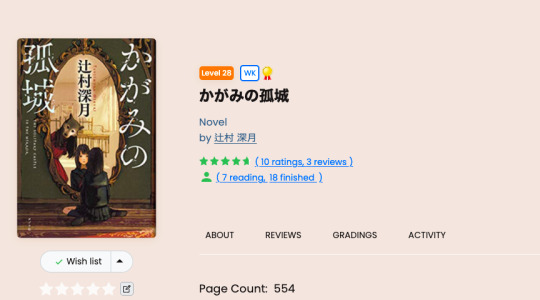
☞Caveat: don't feel discouraged if you found a book to be difficult even though it didn't seem like it would be. Everyone thrives in different areas and different subjects. Just because something was graded at N5 and you had difficulties with it at N3 doesn't mean anything--it might mean that it wasn't something to your liking. There are some series that I have difficulty with because of pacing or because I lacked interest in it.
❀ If you're worried about reading a book or series on your own and you're looking for friends to read and discuss about it with, come join us over on the discord and propose it as an option in the bookclub.
㉄ Can't find a particular book or series that you're looking for on the website? You can request for it to be added here.
★ The website is also equipped to let you "organize" your library into categories and track your reading progress. Additionally, you can make your library and reading progress private if you don't want anyone to see. As I'm currently using this blog to be as open as I can possibly be on my language learning journey, mine is made public. Feel free to check me out on the website.
★This is not sponsored, but if you receive a welcome message from Brandon, the owner and creator of the website, tell him that maobuchou sent you (that's me! ☺️). Brandon is really nice, so if there's anything that you're confused about or if you have suggestions for the website, he has an option for you to contact him.
★If you're interested in seeing what I'm currently reading, what I'm interested in reading next, and what I've graded thus far, click here to follow me (I'll follow back). Following other users allows you take a peek at what books they're reading. I also update my profile to say what book is also being read in the discord bookclub.
There will be more posts to come in the future about ways to become comfortable with reading in your target language.
#onigiristudies#japanese#learn japanese#nihongo#jlpt#resources#natively#jlpt n3#jlpt n2#jlpt n4#jlpt n1#jlpt n5#japanese grammar#japanese vocab#japanese langblr#learning japanese#langblog#japanese vocabulary#japanese studyblr
460 notes
·
View notes
Text
tried going to an N2 preperation class (second highest level of the jlpt test for jpn language proficiency) but i didnt even understand what the teacher said... but this is the level im supposed to study... and i just sat down to read some of the assignments we got and i really have to look up every other word...
#its weird bc its marked as upper intermediate#but its so difficult while the upper intermediate grammar class is completely fine#like they cant decide if upper intermediate means n3 or n2 or even n1#like the upper intermediate kanji class was literally n1
0 notes
Text
I passed N2 btw lmao
#but kinda barely because i got EXACTLY 30/60 from reading section so if i had one less point i would fail the entire exam lmao#but i passed it lmao#then i got 40/60 from vocabulary/grammar and 41/60 from listening#so i had 111/180 points#so not exactly a spectacular result but i passed nevertheless lmao#now it's time to prepare for N1 next year lmao#jlpt
0 notes
Text
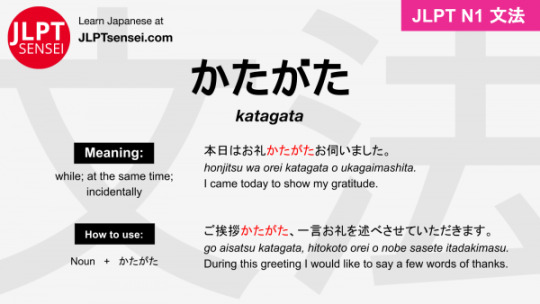
This is a very polite expression mainly used in work or with people of higher social status.
よく使う名詞:ご挨拶、お礼、お見舞い、ご報告、お詫び。
近くまで来ましたので、ご挨拶かたがたお伺いしました。
ちかく まで きました ので、ごあいさつ かたがた おうかがい しました。
I was nearby and so I came to say hello and also to visit.
叔母が体調を崩したと聞いたので、見舞いかたがた手伝いに行った。
おば が たいちょう を くずした と きいた ので、みまい かたがた てつだい に いった。
I heard that my aunt's health was poor, so I visited her and also helped her out.
近々お礼かたがたお伺いしたいと思いますが、ご都合はいかがでしょうか。
ちかぢか おれい かたがた おうかがい したい と おもいますが、ごつごう は いかが でしょう か。
I'd like to visit you in order to thank you in the near future, but would that be convenient for you?
今日は先日ご報告かたがた、部下の紹介に参りました。
きょう は せんじつ ごほうこく かたがた、ぶか の しょうかい に まいりました。
While going through the report from the other day, we also introduced my subordinate.
Source: JLPTsensei
#日本語#japanese#japanese language#japanese langblr#japanese studyblr#langblr#studyblr#文法#japanese grammar#jlpt n1#かたがた
51 notes
·
View notes